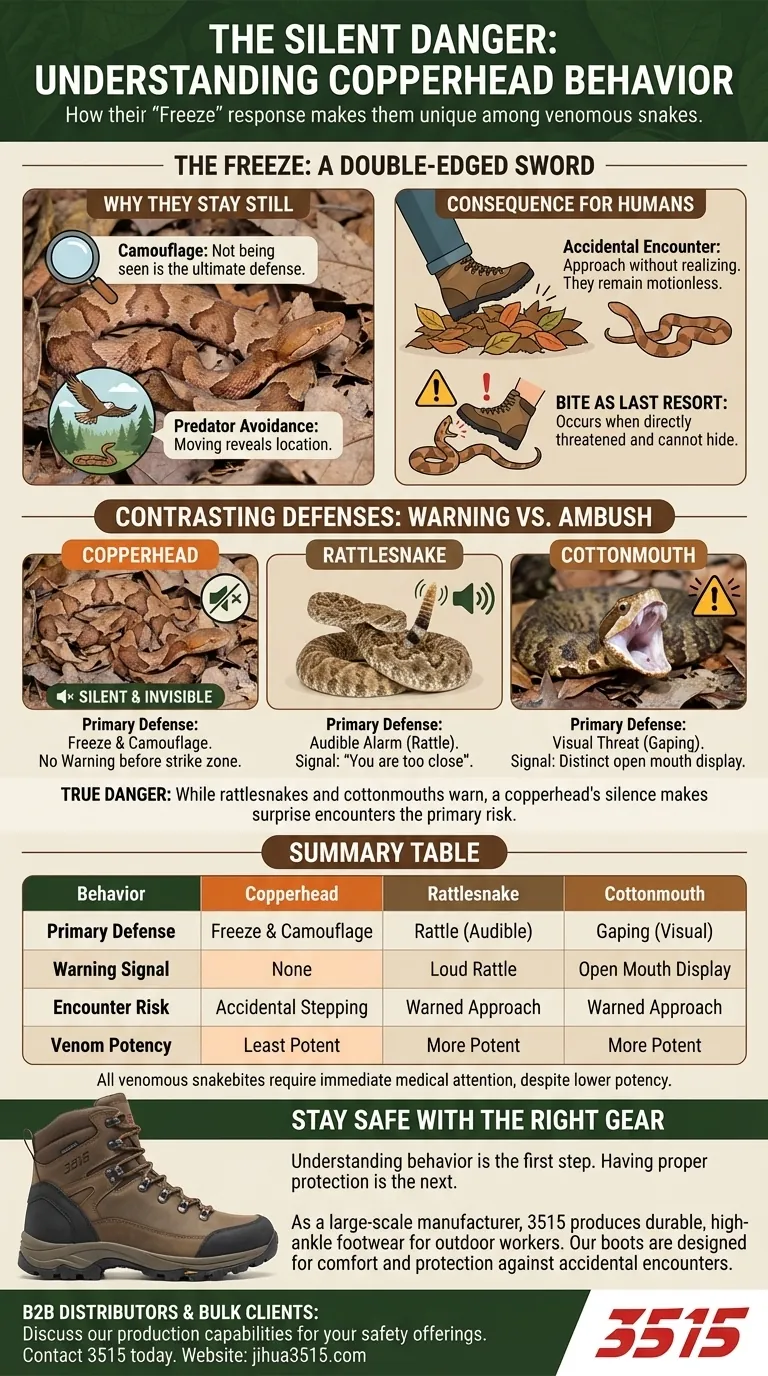The most significant behavioral difference is the copperhead's instinct to freeze and rely on camouflage when threatened. While other venomous snakes often provide clear warnings, a copperhead's primary defense is to remain perfectly still, making accidental close-range encounters—and defensive bites—far more likely.
The true danger of a copperhead isn't in its aggression or venom potency, but in its silence. While snakes like rattlesnakes and cottonmouths often signal their presence, a copperhead's instinct to freeze makes accidental, surprise encounters the primary risk.

The "Freeze" Response: A Double-Edged Sword
A copperhead’s behavior is a masterclass in energy conservation and predator avoidance. Unfortunately, this same survival instinct creates a unique hazard for humans.
Why They Stay Still
A copperhead's coloration and pattern provide exceptional camouflage in leaf litter and forest debris. Its survival strategy is predicated on the idea that not being seen is the ultimate defense. Moving would reveal its location to potential predators.
The Consequence for Humans
This reliance on stillness means people can approach a copperhead without realizing it. The snake remains motionless, hoping you will pass by, but if you step on or right next to it, you have unintentionally called its bluff.
The Bite as a Last Resort
The defensive strike is a copperhead's last-ditch effort when its primary defense—camouflage—has failed. The bite occurs when the snake feels a direct, physical threat from which it can no longer hide.
Contrasting Defenses: Warning vs. Ambush
Understanding how other venomous snakes behave highlights just how different the copperhead is. Most other pit vipers prefer to warn you away to avoid a physical confrontation.
The Rattlesnake's Audible Alarm
The rattlesnake provides the most famous warning in the animal kingdom. Its rattle is an unmistakable audio signal that says, "You are too close, and I will defend myself if you come closer."
The Cottonmouth's Visual Threat
The cottonmouth, or water moccasin, has a distinct visual warning. When threatened, it will often open its mouth wide to display the bright white interior—a behavior called gaping. This is a clear, visual sign to back away.
The Copperhead’s Lack of Overt Signals
The copperhead lacks both an audible and a distinct visual warning. Its defense is its invisibility, which is precisely what makes it dangerous in areas where people walk. You receive no warning before you are in the strike zone.
Understanding the Trade-offs
While its behavior makes accidental encounters more probable, it's critical to understand the full context of a copperhead bite.
Venom Potency
Copperhead venom is considered the least potent of all North American pit vipers, including rattlesnakes and cottonmouths. Fatalities are extremely rare.
The Reality of the Bite
Despite its lower potency, a copperhead bite is still a serious medical emergency. The venom can cause significant pain, swelling, and temporary or permanent tissue damage. All venomous snakebites require immediate medical attention.
How to Apply This Knowledge for Safety
Your awareness of a copperhead's behavior is your best tool for preventing a negative encounter.
- If your primary focus is preventing an encounter: Always be visually aware when walking in wooded areas, especially with heavy leaf litter. Wear sturdy, high-ankled boots and use a walking stick to probe the area ahead of you.
- If your primary focus is risk assessment: Recognize that the danger is not from an aggressive chase but from an accidental step. Pay extra attention near logs, rock piles, and old structures where they may be hiding.
- If you see any snake: Do not try to identify it up close. Give it a wide berth, back away slowly, and allow it to leave the area on its own.
Ultimately, understanding that the copperhead's instinct is to hide, not to hunt you, is the key to coexisting safely with this reclusive snake.
Summary Table:
| Behavior | Copperhead | Rattlesnake | Cottonmouth |
|---|---|---|---|
| Primary Defense | Freeze & Camouflage | Rattle (Audible Warning) | Gaping (Visual Warning) |
| Warning Signal | None | Loud Rattle | Open Mouth Display |
| Encounter Risk | Accidental Stepping | Warned Approach | Warned Approach |
| Venom Potency | Least Potent | More Potent | More Potent |
Stay Safe with the Right Gear
Understanding snake behavior is the first step to safety. The next is having the proper protection. As a large-scale manufacturer, 3515 produces a comprehensive range of durable, high-ankle footwear and boots perfect for hikers, landscapers, and outdoor workers navigating areas where copperheads and other snakes may be present.
Our boots are designed for comfort, durability, and protection—essential for preventing accidental encounters from becoming serious incidents.
Are you a distributor, brand owner, or bulk client looking for reliable safety footwear? Let's discuss how our production capabilities can meet your needs.
Contact 3515 today for a consultation and enhance your safety offerings.
Visual Guide

Related Products
- Customizable Slip-On Safety Shoes Direct from the Factory for Wholesale
- Wholesale Customizable Suede Safety Boots - Puncture-Proof with Velcro Closure
- Wholesale High-Traction Camo Boots - Custom Manufacturer for Brands
- Durable Canvas Work Shoes with Rubber Lug Sole | Wholesale Manufacturer
- Durable Military Combat Boots with Water Drainage for Wholesale & OEM
People Also Ask
- What are the cultural perspectives on wearing shoes in the house? A Guide to Home Etiquette & Hygiene
- What regular maintenance checks should be performed on safety boots? A Daily Safety Checklist
- What is the purpose of ASTM International? A Guide to Global Quality Standards
- What cultural and environmental considerations are tied to wearing shoes indoors? Balance Hygiene, Tradition, and Foot Health
- Why is maintenance important for work boots? Protect Your Investment and Safety



















